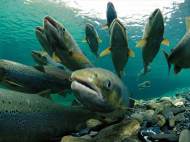Fish biomimicry used for bridge stability sensors during floods
 Floods cut down more bridges than fire, wind, earthquakes, deterioration, overloads and collisions combined, costing lives and hundreds of millions of dollars in damage. The speed and turbulence of an overflowing stream scours away the river bottom that provides the support for a bridge foundation. In order to counter that, researchers at the Case Western Reserve University are designing salmon inspired underwater sensors that relay real-time information.
Floods cut down more bridges than fire, wind, earthquakes, deterioration, overloads and collisions combined, costing lives and hundreds of millions of dollars in damage. The speed and turbulence of an overflowing stream scours away the river bottom that provides the support for a bridge foundation. In order to counter that, researchers at the Case Western Reserve University are designing salmon inspired underwater sensors that relay real-time information.
“We don’t fully understand how scouring takes place”, said Xiong Yu, an assistant professor of civil engineering at the Case School of Engineering. Water passing a bridge support forms vortices which erode the river bottom, but how and at what rate scour occurs is complex. River bottoms usually consist of sand, clay, shale or sandstone or a mix, and each material acts differently when it is exposed to a strong current.
To characterize each vortex, Yu’s lab is building flow sensors based on tiny, hair-like sensors that salmon have on the sides of their bodies. Researchers have found the fish determine flow direction by the direction the hairy cells move and speed by the time delay as turbulence passes different sensors. Yu‘s lab built sensors comprised of micro pillars made with piezoelectric fibers mounted on flexible copper rods. The fibers produce electric signals reflecting flow direction and speed. These have proven sensitive and accurate and the lab is now developing arrays for real-time flow and turbulence sensing.
To determine the amount of sediments being scoured away, his lab has built sensors that constantly measure the topography where the water meets the river bottom around the bridge supports. These sensors employ a technology called time domain reflectometry, in which radar is fired along waveguides installed at critical ground locations. The electromagnetic waves return at different speeds depending on the materials they strike and distance traveled. The waves are analyzed with an algorithm developed by Yu’s lab to reveal minute changes in the depth and density of the substrate sediments.
The sensors proved durable, sensitive and accurate when tested on bridge supports 10-20 feet below the surface. The next step is to determine the maximum depth and flow conditions under which the sensors provide accurate and immediate information. Yu’s lab is also investigating sensors that can monitor the stability of the bridge structure itself. The package of sensors will provide warnings not currently available and enable Yu’s lab to develop computational scouring models and effective scouring countermeasures.









Leave your response!